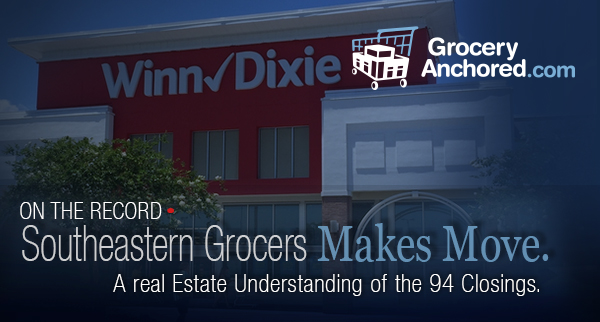With the announcement that Southeastern Grocers would close 94 units last Thursday, 4.5 million people were left with one less grocery store within three miles of their home on Friday. In total 81 landlords owning a combined 7.3 million square-feet across seven states were likely on the phone with their leasing agents within 24 hours. Half a dozen investment sale brokers and their clients went back to the drawing board as marketing efforts on six properties were put on indefinite hold.
Geographically Florida saw the brunt of the closings as 35 units predominantly of the Winn-Dixie variety shuttered their doors. Florida cities Jacksonville, Tampa and Sarasota as well as Columbia, SC each saw three locations close while nine other towns saw as many as two units close. Georgia and South Carolina each saw 19 stores close while Alabama experienced ten closures. Altogether the count registered at 45 Winn-Dixie’s, 26 Harvey’s, 22 Bi-Lo’s and one Fresco y Mas.
Ten REIT’s saw units close under their watch with a single REIT experiencing four closures. Nineteen Regional Landlords (owners of multiple properties across multiple states) experienced closures Thursday with one group experiencing four casualties. Finally, twenty-seven “Mom & Pop” landlords (loosely defined as an ownership group that owns one or two centers within 250 miles of their main offices) will be looking for a new anchor tenant.
From a demographic perspective, the average three-mile population for a closed unit was 48,820 people while the three-mile average income was nearly $61,000 across the 94 former locations. All told there were twenty-six stores that had less than 20,000 people within a three-mile radius. Half of the units had one or no competitors in the trade area. However, one Harvey’s location had as many as six competitors fighting it out for 18,000 people.
The average construction age of these shopping centers was 26 years (est: 1992), and sixteen of them were owned by “Mom & Pop” or private owners. Typically these owners have additional hurdles procuring the year-to-year funds to deploy on necessary capital expenses needed to keep the plaza current. Said another way, SEG is likely not leaving behind LED lighting and parking lot overlays from this Landlord sample. In my opinion, these stores would have closed regardless. Should SEG ever return to the market, many of these boxes will likely be waiting on them (for years).
Twelve former locations benefited from three mile populations north of 100,000 people but could not make EBITDA profitable. With an average construction year of 1987 some of these units saw similar building envelope erosion(s), but from my perspective, the devastating metric was heavy competition. Winn-Dixie was fighting against an average 11 other grocers in this sample. There were several cases the neighboring property was either a Walmart, Publix or in some cases both. In one example 17 competing grocers surrounded a particular Winn-Dixie paying only $7/SF base rent on a nearly 30 year-old lease. The competition forced SEG into three consecutive years of sales decline. That said, the owner of the center will have little problem backfilling the space well into the double-digits.
The remaining “middle” former 56 units should be studied on a case by case basis, but at the end of the day, there is good news.
Though it may be too early to talk silver linings, GroceryAnchored.com estimates $800-$1 billion in annual sales will be looking for a place to shop in the weeks to come. This displaced shopper demographic tends toward existing grocery formats and customary purchasing habits. In other words, phrases like “delivery,” “click & collect” and “Amazon/Whole Foods” do not register with many of these shoppers.
Publix (the tenant) saw 121 of its stores benefit from being within the trade area of the 94 dark units. Southeastern Grocers themselves will have 37 units that should see a sales bump with one less competing grocery store. 29 Walmart Neighborhood Market’s, 27 Food Lion’s and 26 Save-A-Lot’s round out the majority with Aldi having seven and the rest of the list with other banners seeing only a slight uptick.
From the Landlord side of the equation, Publix (the Landlord) will enjoy 39 shopping centers with one less competitor within three miles of its front door. Regency and Brixmor will enjoy nine and eight centers respectively that will be positively impacted by one and in some cases two fewer competitors, while Weingarten will likely experience increased sales at four of their centers.
Final Thoughts
At the end of the day, this should have been worse. The bankruptcy and subsequent closings have been percolating for months, and the market is happy to put this capital event in the rearview mirror. Many wrongly predicted (myself included) 150 to as many as 200 units. Should twenty-two Fresco-Y-Mas conversions not happen, there could have been a string of locations in South Florida for release. Furthermore the SEG Real Estate team worked tirelessly in negotiating with Landlords for months to push down rents and salvage an untold number of units. As a result of their efforts and Landlord capitulation, I would estimate they saved seventy-five units or more. If you think that through, an average store has about 80 employees, thus 6,400 jobs across the Southeast were saved not including the units that were sold in Louisiana in the weeks prior to the announcement (these are my estimates).
Overshadowed in the announcement is the fact that Southeastern Grocers continues on their store redevelopment plan with healthy targets for the balance of the year and into 2019. For that to happen the Landlord community will need to buy into the vision. With the capital event behind the retailer, the ball is now firmly in Southeastern Grocers court.

